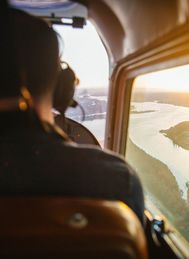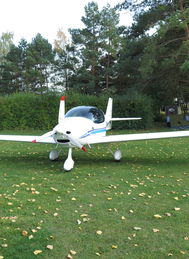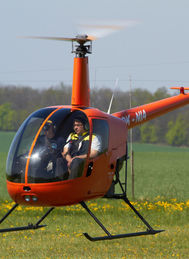Date: October 7, 2015
The helicopter, like any other buoyancy device, can fly glides. It gains energy at the cost of losing height. Just like a glider. Only the angle of descent is much steeper. However, the speed of descent is sufficient to save the life of the crew and to save the helicopter itself.
Helicopter flight without engine power is called autorotation mode. In this mode, the rotor rotates in the same way as the gyroplane (hence the gyroplane is called an autogyro). I won’t bore the reader by drawing the distribution of forces on the profile, let's just say, simply, that the rotor rotates in such a mode due to the fact that sufficient air flows through it from bottom to top. This is the fundamental difference from motor flight. With engine power, air flows from the top to the bottom of the support rotor. And the transition between these two modes is critical for light helicopters! Why? Here it is first necessary to look at the rotor blades. It takes a little longer, but it’s important for understanding it properly. So please stay tuned:
There are multiple ways of attaching the blades of the support rotor. Each method used has its advantages and disadvantages. In small helicopters (in our conditions) the most widespread so-called "semi-solid rotor" is controlled by an inclined plate. Robinson and Kompressors have such a rotor head. Why semi-solid? Because the blades are attached to the rotor head by a single pin which allows the blade to move up and down (waving). This is important because the helicopter is controlled by cyclic changes of the rotor blade settings around the periphery of the rotor disc - this sounds awful but simply put: as the blade rotates around, it will have a greater angle of attack on one side than when running across the other side and thus one side will bring more buoyancy and the helicopter will move in the desired direction. Well, and since on one side the blade will have a greater angle of attack, it will tend to move up. That's why the pin is there. It is therefore clear that the position of the blade is not determined by its mounting on the rotor head flange, but by the distribution of the buoyancy and centrifugal forces! If you look closely at a flying helicopter, you will see that the rotor blades will rise to a shallow V. If the revolutions are exceeded, the bearings of the rotor head may be damaged first and then the rotor may burst. However, when the speed drops, the buoyancy force will prevail over the centrifugal force and the rotor blade will wave disproportionately high. The entire rotor is hung on the center pin like a children's swing and the same thing happens when the swing opposite you jumps upwards. The second leaf drops sharply, crashes into the tail beam and the flight is over. Even if the second blade does not drop, blades raised too high can no longer start to spin again and the helicopter won’t be able to go on flying.
And back flying. As soon as the engine fails in a forward flight, light helicopters have enough time to switch to autorotation (Robinson R22 states 1.2 sec). It is necessary to immediately move the collective control lever down vigorously, as far as possible and at the same time to move the collective relatively vigorously a little bit toward you and immediately return a little. Not to the original position! What will this achieve? By the collective, you will reduce the angle of the blade settings so that they do not create as much resistance and by the cyclics you will quickly change the angle at which the air approaches the rotor. It is necessary to get as much air into the disk from below! This keeps the rotor in rotation and the individual blades will create buoyancy.
It sounds a bit complicated again, but just think about what you really need at the moment:
reduce the resistance of the blades to turn willingly - the collective down
get as much air as possible from below into the rotor disk to rotate it - cyclics to yourself = helicopter stretch
Well, the next part is also interesting. You need sufficient forward speed to successfully perform an autorotation landing. Perpendicular autorotation is also theoretically possible, but in one book discussing this issue, they wrote euphemistically that "at perpendicular autorotation, it is extremely difficult for a pilot to recognize the right moment when to brake the descent by pulling the collective while landing". In other words, I always stumbled! So we will stick to good practice and land with forward movement. When training autorotations, you will soon find out that rotor speed and forward speed are mysteriously related. As soon as you try to gain speed, the speed starts to decrease. As soon as you brake, the speed increases. Why? This is due to the angle at which air enters the rotor disk. The larger the angle, the more air passes through it and the more the rotor rotates. You need to practice this. You must not reduce the rotor speed at a low speed by pulling the collective. It is like that - left up, right forward, left down, right even more forward, and in a few moments you don't know which hand is which, and can’t even watch what they are both doing. But there is one simple aid. Keep one eye on the rotor speed indicator and observe the movement of the hand with your left hand (collective). When it goes down, also move the collective down. When it goes up, then move your hand up as well. Keep the right speed with your right hand. It works pretty well. But like everything, autorotational techniques must be properly trained. Don’t be under the illusion that by reading the procedure and showing some indications of autorotation by the instructor, you are ready to save your life when the engine stops. It is really necessary to learn autorotation. A helicopter, unlike aircraft, cannot fly itself. You really have to fly the helicopter until the rotor stops.
How to choose a landing area, where to fly and where not to, is basically the same for a helicopter as for an aircraft. The helicopter does not have such a long range without the engine, on the other hand, it needs a lot less space for landing. Beware of soft surfaces! When landing on a soft surface with too high of a forward speed, the skids usually make their own tracks and if you do not keep the helicopter perfectly straight, it will flip over.
But the helicopter also needs some space to approach by forward flight and level. Don’t believe the stories about the pilot, who cut his way into the garden, landed and nothing happened!
You must not stretch a helicopter too much while landing. Don’t forget that the tail beam is very long and if you stretch the helicopter too much too low, the helicopter will hit the ground. However, it must not be too high, because the energy accumulated in the rotor's movement quickly occurs when the level is low and you have only a short moment to land.







